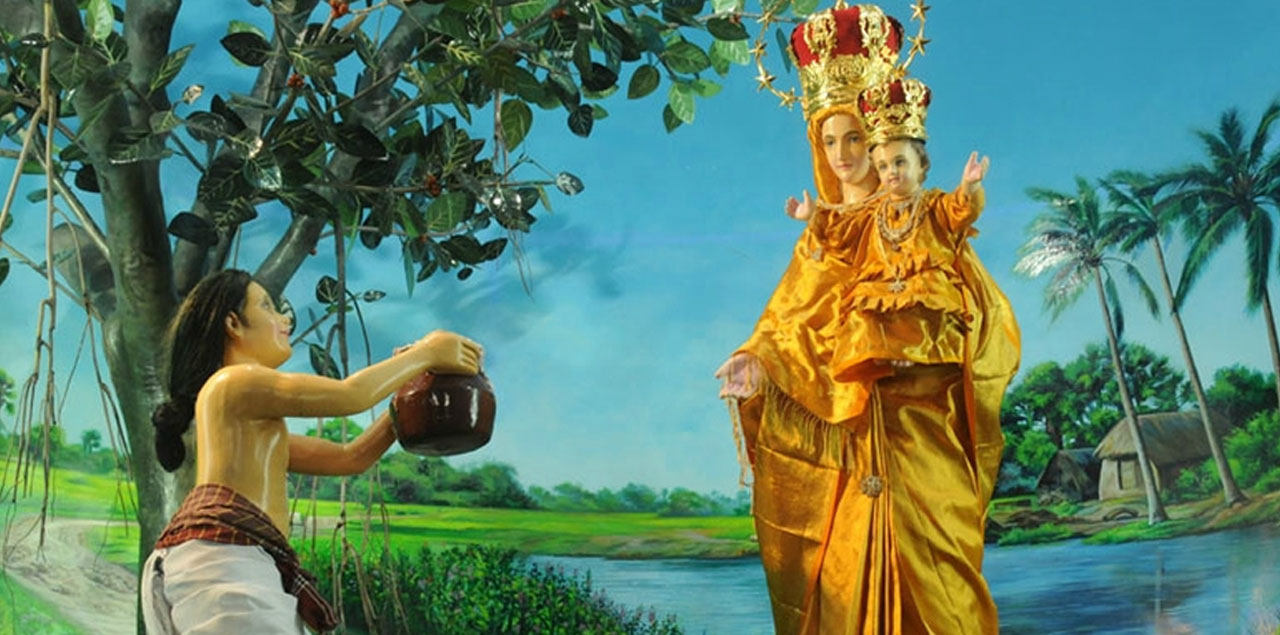Across pockets of the Subcontinent, the recent coronavirus pandemic triggered collective memories of similar devastation in the not-so-distant past. It amplified painful echoes from the outbreak of the bubonic plague, influenza and smallpox that have ripped through the land in the 19th and 20th centuries. It also reignited faith in the devis, matas, ammas and other female divinities who have been called upon, time and time again, to save humanity from its own hubris.
Many Indian cultures nurture the belief that each phase of human life is controlled by a particular holy power. Disease is regarded as divine rebuke to be appeased with the redoubling of faith. To this end, various health-giving and -destroying deities have manifested all over India. These are fierce goddesses, praised in folk stories and legends, and worshipped primarily by lower caste, Dalit, Bahujan and tribal communities who have been excluded from Vedic Hindu temples and rituals.
Chicken pox, for example, is believed to be a sign that the sufferer has been possessed with the spirit of Shitala Mata, who shows herself in the delirium of a high fever. There is a psychological benefit to this idea. While it inspires a terrified reverence for the Goddess, it also provides a glimmer of hope during dark, uncertain times. If the Mata is pleased with your faith, you may be healed. Hope can be a potent medicine and Shitala Mata, along with a whole pantheon of healing goddesses, is the locus of its power.
This divine maternal shield is invoked even today against the contagion of poxes, pustules, sores, fevers, plagues and most recently, even Covid-19, which birthed Corona Maa and Coronadevi. Interestingly, it is never health gods that are called upon for rescue. Even in the spiritual realm, caregiving is a woman’s work.
Shitala Devi
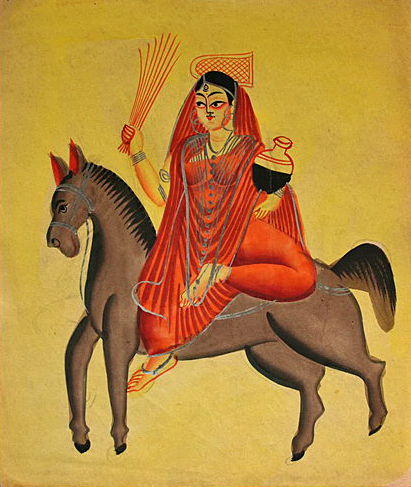
Shitala Devi, Kalighat painting, 19th century, Unknown author, Public domain, via Wikimedia Commons
Arguably the best known of all health-giving goddesses in India, Shitala Devi’s influence ranges across the country, barring the South. She is regarded as the mother who “presides over smallpox, and may prevent smallpox, cause smallpox or be herself smallpox”. Considered as a reincarnation of Goddess Parvati, she is worshipped largely by people of Hindu and Buddhist faiths, and from Bahujan and Adivasi communities.
Shitala, meaning ‘the cool one’, has often appeared iconographically with an earthen pot of healing cold water and a broom to ward off germs. In her primitive form, Shitala was only ever in charge of smallpox, but later she became regarded as the protector of children. Apart from times of infection, rituals for her worship are performed on particular days of the years, per the Hindu almanac, mostly by mothers.
Typically, the families observing Shitala Devi rituals don’t light the stove on certain Ashtami and Saptami days, to essentially “cool off” the stove. Instead, they prepare celebratory foods the day before, to be eaten as thanda khaana (cold food) prasad, the next day. Instances have also been recorded of ritual smallpox inoculation via infected pus. Side-effects of this inoculation are treated with the eating of cold, stale food.
Mariamman
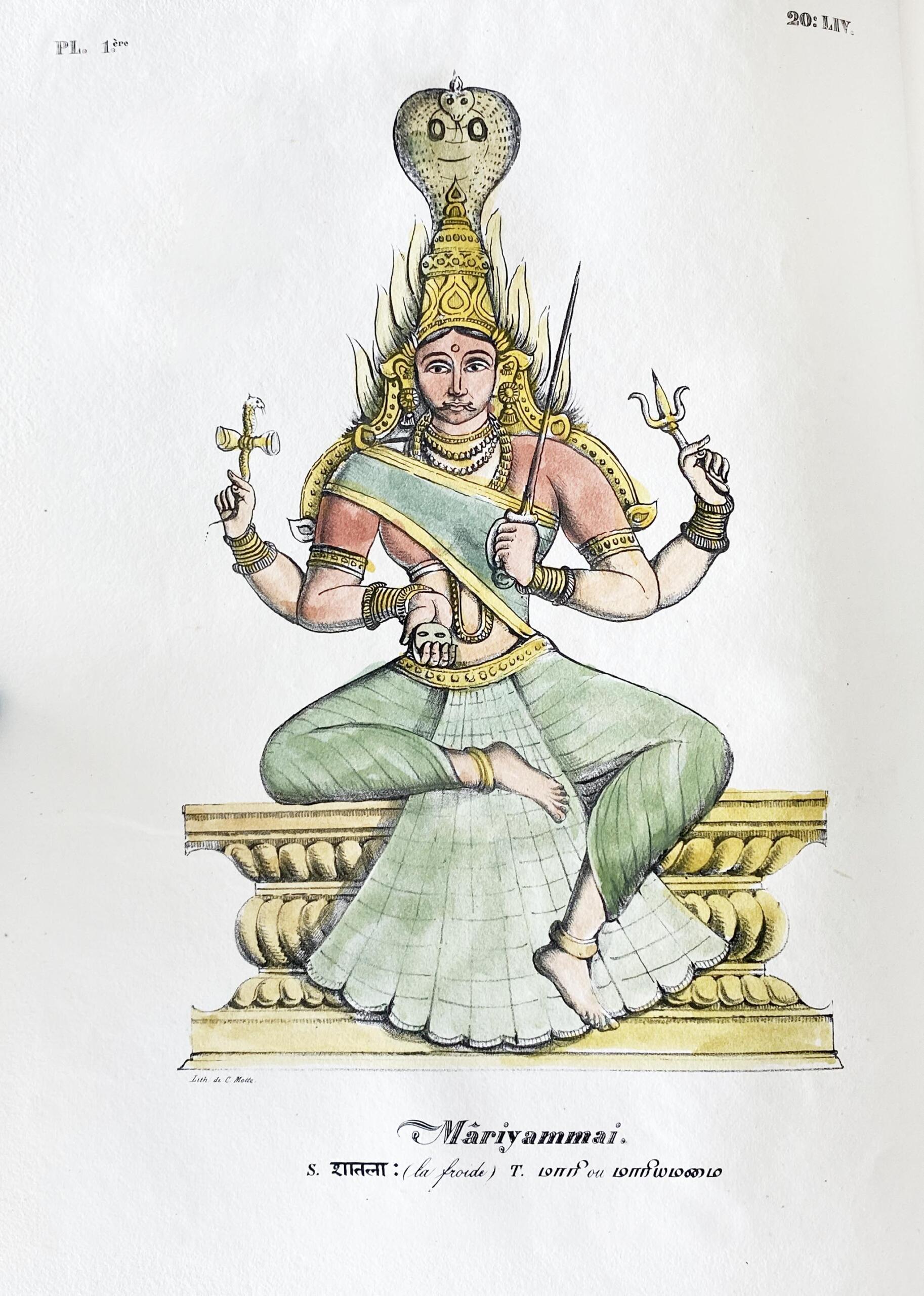
Mariamman from ‘French India: Or Collection of Drawings representing the Divinities, Temples, Furniture, Ornaments, Weapons, Utensils, Religious Ceremonies and Scenes of Private Life’, 1827-1835, by Eugène Burnouf and Eugene Jacquet © Sarmaya Arts Foundation
Primarily venerated in the South of India, Mariamman appears to have taken on the duties of Shitala for this region as the contagion goddess. She’s known to be the bringer of rains and as the healer of water-borne and other diseases including cholera, smallpox, measles and chicken pox. Her worship seems to have originated in Dravidian folk religion, part of the faith practised by the inhabitants of southern India before the onset of Vedic Hinduism.
Just like her counterpart in the north, Mariamman is believed to inflict, embody and cure illness. Ailing patients seeking reprieve from her wrath are treated with a paste of medicinal neem leaves to soothe pox blisters, and fed cooling, light coconut water and curds. They must refrain from taking daily ablutions and baths, eating large meals and having sex or even speaking. Amma, as she is affectionately called, is worshipped with a prasadam of Pongal, made with lentils and rice in a clay chatti.
Manasa Devi
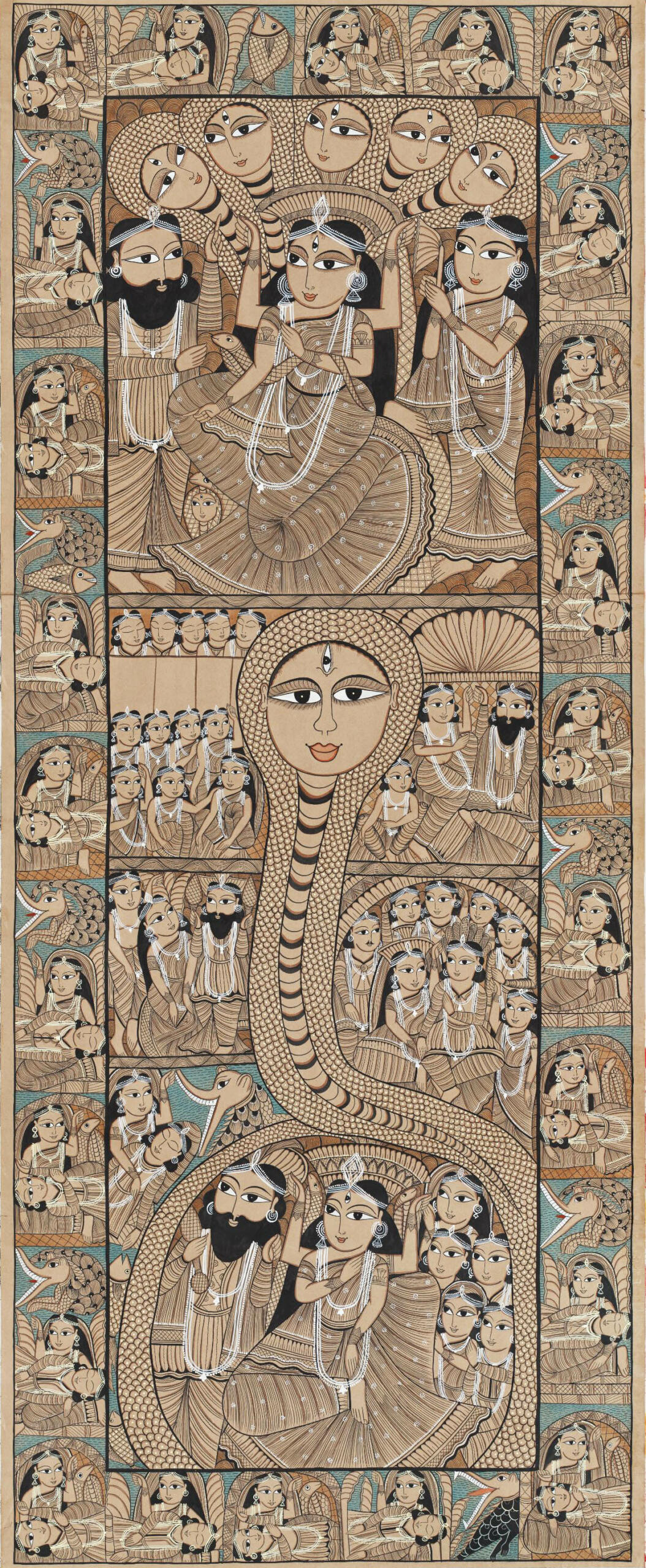
Manasa Pata, early 21st century, Tempera on paper pasted on cloth, by Tagar Chitrakar © Sarmaya Arts Foundation
Manasa Devi is worshipped as the goddess of snakes, predominantly in the Bengali provinces and the Hindu Assamese north-eastern belt. The presence of a serpent goddess is hardly surprising in India where there is a long history of serpent and naga worship.
Much like the other village deities, the cult of Manasa too stems from indigenous tribal stories as a goddess that protects people from snake bites, especially in the Gangetic delta where serpents teem during the rains. One version of the Manasa saga even reads, “When a sage dies, he goes to the sun..but a victim of snakebite goes to the domain of Manasa.” She is depicted often, seated in an elegant lotus posture with serpents emanating all around her and at her behest.
Her primary characteristics are said to be destruction and regeneration. She destroys ruthlessly and wantonly, the innocent with the guilty, to demonstrate her might; she has the power to bring her victims back to life once they submit to her power. Her regenerative powers are not separable from her role as a snake goddess. The snake represents life and death, as it regenerates itself periodically in the shedding of its skin.
Her stories have been told in the form Patta Chitra, an ancient storytelling tradition through paintings and poetry in song by people from various faiths. These stories are told often picked from the medieval text Manasa Mangal Kavya. More recently, legends of Manasa Devi’s shrine, wrath and protection has also been the central theme of Amitav Ghosh’s novel, Gun Island.
Oladevi/Olabibi
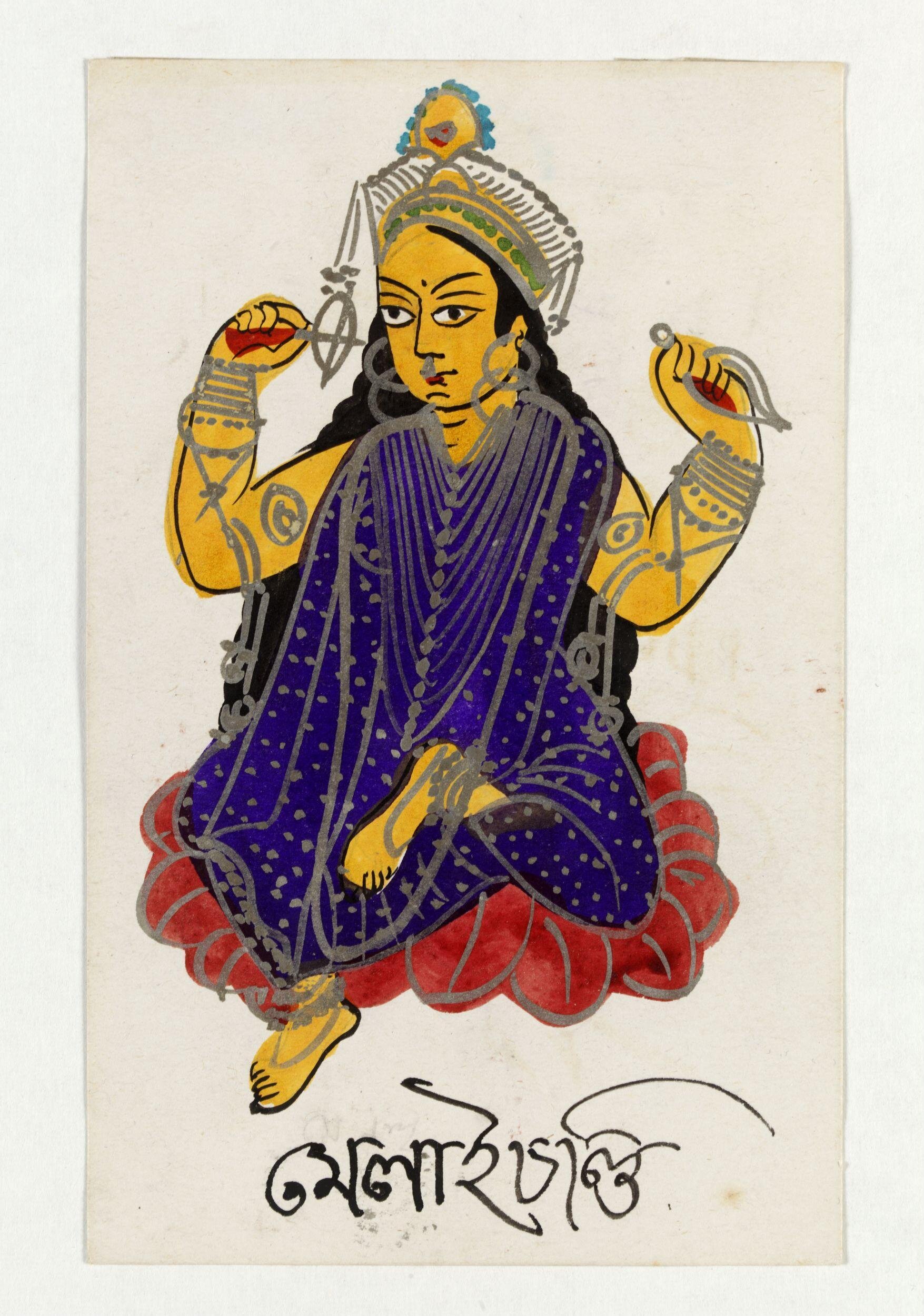
Olai Changi, Kalighat painting, c 1890 © Victoria and Albert Museum, London
Oladevi is a secular folk deity worshipped by Hindus, Muslims and Adivasis of the Bengal region for protection against cholera. Named after the Bengali term for cholera ‘ola utha’, she’s Oladevi to her Hindu devotees and Olabibi to Muslims.
The global spread of cholera began from the Gangetic delta and the first case was documented in Bengal in 1817. It was the start of what’s regarded as the first pandemic. The region and Bengali culture has been marked by frequent outbreaks of the deadly disease, warranting a goddess with only one mandate: to safeguard believers from cholera. Enter, Oladevi.
Her imagery was defined by the faith of her people. In Hindu-majority areas, Oladevi is depicted to resemble goddesses Lakshmi and Saraswati, clad in a blue saree and adorned with ornaments. In Muslim spaces, Olabibi (‘bibi’ meaning gentlewoman) resembles a beautiful teenage girl from an aristocratic family, wearing a long loose garment with pajama, scarf and ornaments. She is venerated with offerings of sweets, betel leaves, areca nuts, rice and cane sugar. Oladevi has many shrines to her name, though her popularity has waned with the advance of modern medical science.
Velankanni
Life-saving apparitions of the Virgin Mary around 16-17th centuries in a sleepy town along the Coromandel Coast gave rise to the legend of Our Lady of Good Health, Velankanni. While there are no historical records, strong oral traditions dictate that these apparitions of the Virgin Mary took place in the town of Vellankani in Tamil Nadu.
Through these apparitions, Velankani Mata is believed to have restored the limbs of a disabled boy, miraculously refilled a pot of milk and rescued Portuguese merchant sailors from a violent storm and shipwreck. And it was these Portuguese merchants who built and developed a chapel in her honour about 150 miles south of Chennai. Now referred to as the ‘Lourdes of the East’, the Vellankanni Mata chapel has transformed into a major basilica and its annual feasts attract over a million devotees.
Though primarily patronised by Roman Catholics, the basilica of Velankanni welcomes pilgrims of all faiths from around the world. Over the course of its 400-year history, the Madonna here is said to have alleviated miseries and granted countless favours to her worshippers. In the aftermath of the catastrophic 2004 Indian Ocean tsunami, she is believed to have saved the lives of those inside the church.
Interestingly, the sculpture of the Madonna with infant baby Jesus in the basilica has her wearing a saree. It is also customary to offer saree, candles and a cradle (for the baby Jesus) at the Velankanni shrine. The church seems to bring together many Catholic beliefs that have blended with Hindu rituals and traditions, drawing parallels between the Virgin Mary and the divine mother goddesses of India. Among the shared customs are devotees tonsuring their heads and conducting padhyatras or journeys on foot from their hometowns to the shrine during feast celebrations.
Hadkai Mata
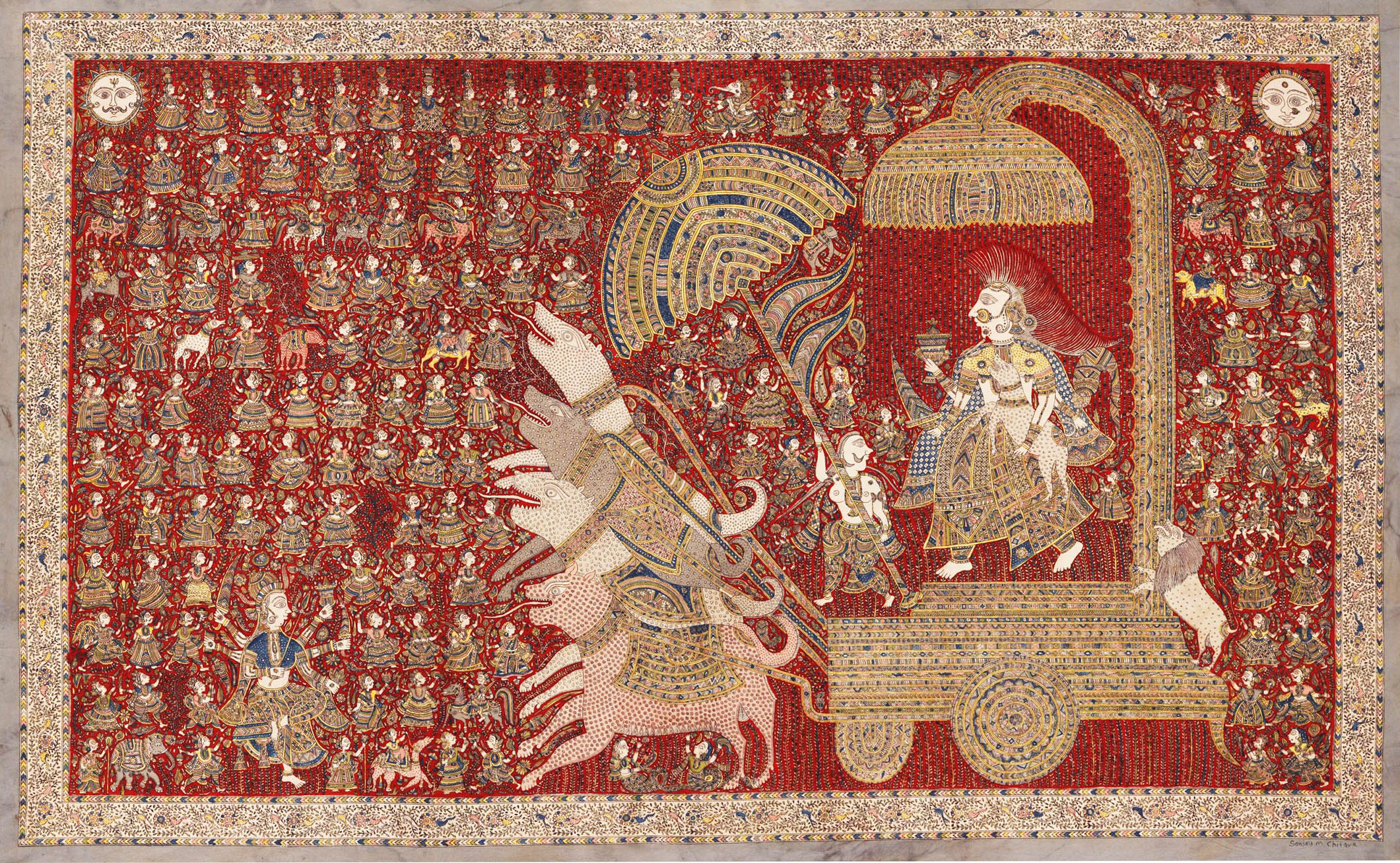
Hadkai Mata (Mata ni Pachedi), 21st century, Cotton cloth hand painted and block printed with natural dyes, Sanjay M Chitara © Sarmaya Arts Foundation
Hadkai, Hadak mata or Hadaksha mata is worshipped by the Vagharis and other lower-caste communities of Gujarat and Rajasthan for protection of people and livestock against rabies. Hadakwa is the Gujarati word for rabies.
Hadkai Mata inspires the performance of faith-healing practices.Those who anger or underestimate her are said to attract the ire of the goddesss, which takes the form of an attack by the rabid dogs at her command. This is why she’s also called Nyaya Ni Devi or Goddess of Justice. The staunchest of her followers reject modern medicine in the event of dog bites, believing that only the will of the goddess can save them.
To seek redemption and healing, believers follow an involved ritual. This includes being tied by the wrist or neck with a thread, as the subject makes promises of eternal subservience to the goddess. In various textile paintings such as those created by award-winning artist Sanjay Manubhai Chitara, Hadaksha Mata is depicted standing on a chariot pulled by four fearsome hounds.
References
M. Williams, 1897, Indian Mother Worship, reprinted from the Athenaeum of Dec. 6, 1879 by H. C. Coote in Folklore Record, Vol. III, Pt. I., p. 120.
Misra, B. (1969). “Sitala:” The Small-Pox Goddess of India. Asian Folklore Studies, 28(2), 133–142.
Old Rituals For New Threats: Possession And Healing In The Cult Of Sitala (in Ritual Matters: Dynamic Dimensions In Practice, ed. by Ute Husken, Christiane Brosius, 2019)
Congress, Indian History (1980). Proceedings. Indian History Congress. p. 100.
Pollitzer R. Cholera. Geneva: World Health Organization. 1959.
Bray RS. Armies of pestilence: the impact of disease on history. New York: Lutterworth Press; 1997
Our Lady of Velankanni, the “Lourdes of the East” celebrates 50 years
Government of India. Ministry of Fisheries, Animal Husbandry & Dairying. National Action Plan for dog Mediated Rabies Elimination by 2030. (2021). (accessed December 12, 2021)
Front. Vet. Sci., 15 June 2022, Sec. Veterinary Humanities and Social Sciences
Manasa-vijaya of Vipra-dasa, p. 204. The full passage reads: “A muni at his death goes to the sun [tisdmpati or tvisampati]; [but] the husband of Behula died because of a snake [sarpa-upa.tambhe]. Having gone to the place of snakes [sarpayoni payyd], he remains in the house of Manasa [manasd-sadane].
Dimock,, E. C. (1962). The Goddess of Snakes in Medieval Bengali Literature. History of Religions, 1(2), 307–321. doi:10.1086/462451

